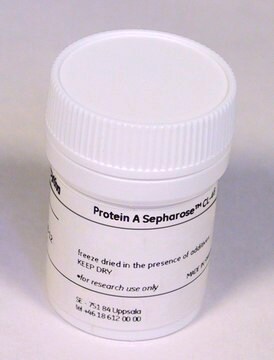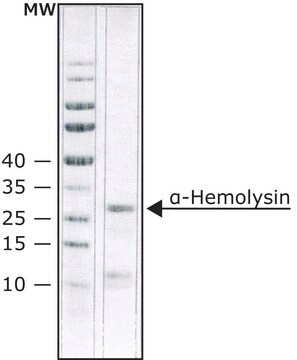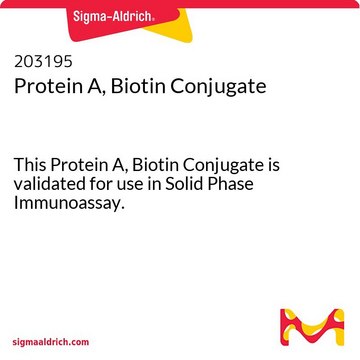P6031
Protein A from Staphylococcus aureus
Soluble, essentially salt-free, lyophilized powder, extracellular
Synonym(s):
Protein A resin
Sign Into View Organizational & Contract Pricing
All Photos(1)
About This Item
Recommended Products
biological source
Staphylococcus aureus
Quality Level
conjugate
unconjugated
form
essentially salt-free, lyophilized powder
capacity
7-14 mg/mg, solid binding capacity (human IgG)
solubility
H2O: soluble 1 mg/mL, clear, colorless
UniProt accession no.
storage temp.
2-8°C
Gene Information
Staphylococcus aureus subsp. aureus NCTC 8325 ... SAOUHSC_00069(3919448)
Looking for similar products? Visit Product Comparison Guide
General description
The bacterial strain is a derivative of a strain from Cohen, S., and Sweeney, H. M., J. Bact., 140, 1028 (1979).
Application
Protein A from Staphylococcus aureus has been used:
- to coat nitrocellulose sheet with protein A for immunoassay of agalactosyl IgG.
- as a blocking agent before the use of secondary antibody in immunohistochemistry.
- as a binding agent to antibody during antibody immobilization.
Protein A may be conjugated with various reporter molecules including fluorescent dyes (FITC), enzyme markers (peroxidase, β-galactosidase, alkaline phosphatase), biotin, and colloidal gold without affecting the antibody binding site on the molecule. These conjugates are used to detect immunoglobulins in various immunochemical assays including western blotting, immunohistochemistry, and ELISA applications. In addition, protein A may be immobilized on a solid support such as agarose or acrylic beads for the purification of either polyclonal or monoclonal immunoglobulins. It is also routinely used for immunoprecipitation assays.
Biochem/physiol Actions
Protein A is a highly stable cell surface receptor produced by several strains of Staphylococcus aureus. It consists of a single polypeptide chain of molecular weight 42 kDa, containing four repetitive domains rich in aspartic and glutamic acids but devoid of cysteine. It contains little or no carbohydrate and only 4 tyrosine residues and no tryptophans. Protein A is capable of binding to the Fc portion of immunoglobulins, especially IgGs, from a large number of species. One protein A molecule has been shown to bind at least 2 molecules of IgG simultaneously. The IgG binding domain of Protein A consists of three anti-parallel α-helicies, the third of which is disrupted when the protein is complexed with the Fc region of the immunoglobulins. Protein A will bind the Fc portion of human IgG subclasses, IgM, IgA and IgE; and mouse IgG1 (weakly), IgG2a, and IgG2b. Protein A also binds IgGs from other species, including monkey, rabbit, pig, guinea pig, dog, and cat.
Protein A also participates in a number of different protective biological functions including anti-tumor, toxic, and carcinogenic activities. In addition to acting as an immunomodulator, it also has antifungal and antiparasitic properties.
Protein A also participates in a number of different protective biological functions including anti-tumor, toxic, and carcinogenic activities. In addition to acting as an immunomodulator, it also has antifungal and antiparasitic properties.
Preparation Note
Purified from culture medium of a protein A-secreting S. aureus strain.
Disclaimer
Unless otherwise stated in our catalog or other company documentation accompanying the product(s), our products are intended for research use only and are not to be used for any other purpose, which includes but is not limited to, unauthorized commercial uses, in vitro diagnostic uses, ex vivo or in vivo therapeutic uses or any type of consumption or application to humans or animals.
Storage Class Code
11 - Combustible Solids
WGK
WGK 3
Flash Point(F)
Not applicable
Flash Point(C)
Not applicable
Personal Protective Equipment
dust mask type N95 (US), Eyeshields, Gloves
Choose from one of the most recent versions:
Already Own This Product?
Find documentation for the products that you have recently purchased in the Document Library.
Customers Also Viewed
Masayasu Suzuki et al.
Analytical and bioanalytical chemistry, 372(2), 301-304 (2002-04-09)
Miniaturized immunosensors based on surface-plasmon resonance (SPR) have been developed by using the sensor recently developed by Texas Instruments. By using this sensor for human immunoglobulin G (IgG) rapid and repetitive measurements could be performed by alternate injection of sample
R Dubé et al.
Gut, 31(4), 431-434 (1990-04-01)
The proportion of oligosaccharide chains on the Fc fragment of IgG which terminate with N-acetylglucosamine (GlcNAc) rather than galactose is increased in rheumatoid arthritis and tuberculosis, and in sera from patients with Crohn's disease, probably because of decreased activity of
Shiori Toba et al.
Proceedings of the National Academy of Sciences of the United States of America, 103(15), 5741-5745 (2006-04-06)
Structural differences between dynein and kinesin suggest a unique molecular mechanism of dynein motility. Measuring the mechanical properties of a single molecule of dynein is crucial for revealing the mechanisms underlying its movement. We measured the step size and force
K Reithmayer et al.
The British journal of dermatology, 161(1), 78-89 (2009-05-07)
Hair follicle (HF) ostia represent a potential port of microbial entry into the skin. However, they rarely show clinical signs of infection. This suggests the presence of local, efficient, antimicrobial defence systems, which may include antimicrobial peptides (AMPs). We determined
Shiori Toba et al.
Cell motility and the cytoskeleton, 58(4), 281-289 (2004-07-06)
Cytoplasmic dynein is a minus-end directed microtubule motor and plays important roles in the transport of various intracellular cargoes. Cytoplasmic dynein comprises two identical heavy chains and forms a dimer (double-headed dynein); the total molecular weight of the cytoplasmic dynein
Our team of scientists has experience in all areas of research including Life Science, Material Science, Chemical Synthesis, Chromatography, Analytical and many others.
Contact Technical Service










